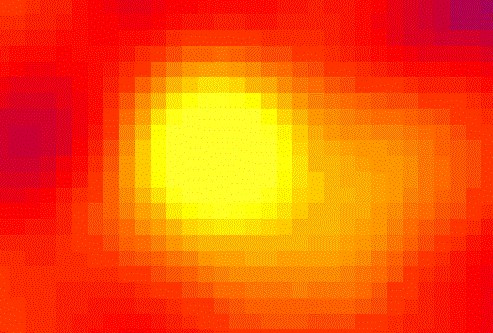
| | magnetars | | black holes | | distant redshifts | | formation of Earth | | thunder storms | |
| speculative phenomena not (yet?) associated with GRBs | ||||
- Magnetar is a term applied to
neutron stars with enormous magnetic fields. When the magnetic fields
become exceptionally stressed, they collapse
catastrophically. The
collapse can release vast amounts of energy in seconds as a gamma ray
burst. When the stress is due to material falling onto the magnetar
from a companion, the gamma rays are less energetic than in some
bursts, hence "soft," and also repeated in cycles of accumulation and
explosion. These are "soft gamma ray repeaters." (Kouveliotou et al. in
the May 21, 1998 issue of Nature. See also
an excellent web site on the
subject by Dr. Robert Duncan, May, 1998)

Simulation of magnetic field lines on the sun (NASA/SOHO)
(A similar process in "miniature" occurs on our sun: kinked or looped magnetic fields reach a point of collapse when they release a burst of energy that reaches us as a solar storm. The radiation is much weaker than a gamma ray burst, but it is strong enough to be unhealthy or lethal without special shielding to people in space and to disrupt satellite communication. Particles ionized by the radiation spiral into Earth, especially at the poles, creating aurorae and disrupting many kinds of electrical activity.) - Most recently, evidence suggests
gamma ray burst generation in the process of black hole formation after
the largest supernova explosions. (See, for instance, the ESO
site and the original
publication in Nature, 15 Oct 1998, by
T. Augusteijn et al.) The centers of most supernovae collapse into
neutron stars, but exceptionally massive stars consisting mostly of
carbon and oxygen could collapse into black holes and generate a strong
enough shock wave to cause a gamma ray burst. Now that a few optical
counterparts of gamma ray bursts have been detected, such "hypernovae"
have been observed. A quasar has also been detected as an optical
counterpart to a GRB.

Optical counterpart to GRB970228 visible as a "smudge" extending toward the lower right. Detection of optical counterparts has allowed spectra to be captured and hence redshifts to be measured. J. van Paradijs (UAH) et al., HST, NASA

Apollo 17 view of Earth (NASA)
- Redshifts have also been measured recently on seven GRBs (probably more by now). None of the bursts are anywhere near Earth, and some are halfway out to the edge of the universe. Assuming the source radiates in all directions, the energy production is--well--astronomical. One burst briefly outshone the whole universe, if that assumption is correct. This has led some scientists to think that the energy must be beamed from the poles of the exploding object, in which case much less total energy is released. Some recent evidence (chiefly to do with lack of polarization of the incoming gamma ray radiation, as I understand it) suggests that we are indeed seeing beams. If some or most GRBs are beams, however, that means there are many more of them out there than previously thought because we only see the ones directed toward us.
- In related news about gamma ray bursts, a nearby gamma ray burst may have been instrumental in sparking the formation of rocky planets in our solar system.
- Terrestrial gamma-ray flashes (or TGFs) are short blasts of gamma-ray energy associated with major thunderstorms discovered by the BATSE team shortly after the satellite carrying BATSE was launched. The flashes only last a few milliseconds and can only be detected by satellites orbiting the Earth. After eight years of observations, the BATSE team has detected 70 TGFs, but this is probably only a (small?) subset of all the flashes during that time.
Iron-rich particles are a common form of dust in our solar system, and still form the majority of meteorites. However, some astrophysicists think that the particles would normally settle too quickly on to the parent star to allow the formation of rocky planets. Brian McBreen and Lorraine Hanlon of University College Dublin (Adler in New Scientist, 11 Sep. 1999 issue) suggest that a gamma ray burst within 300 light years of the sun flooded the protoplanetary disk with enough energy to fuse material worth tens of Earths. The iron-rich particles soaked up the gamma rays and X-rays and fused into larger bodies in a matter of minutes.
If it is true that particles would normally settle quickly, and that a massive external influx of energy is necessary to form rocky planets, that would imply that solar systems like ours may be rare.
| |
| Red sprites. Another form of jets of energy extending briefly far above major thunderstorms. Similar pulses of gamma rays have recently been observed. (Red sprite photo: D. Sentman (U. Alaska) et al., EXL98 Campaign, AFRL, NRL, USAFA, NASA) Astronomy pictures NASA archive site |